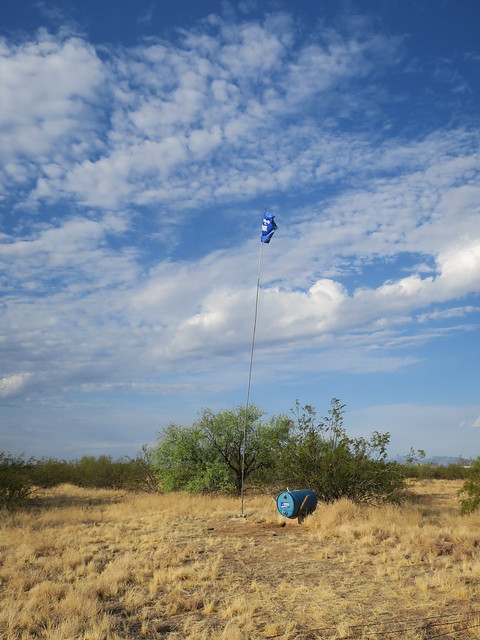 |
| View of sacred mountain, Baboquivari, through the Wall. Sasabe US and MX. July 2019. |
Being part of a water run for Humane Borders offers four-fold benefits:
- Take an action that might save lives;
- Give eyewitness testimony to friends and family about the effects of government decisions on the lives of individual women, men, and children;
- Hear fresh perspectives on borderland issues from fellow water-truck passengers; and
- Revel in the sensory gifts of the Sonoran Desert, which indiscriminately transfixes and kills.
 |
| Water being transferred in Sasabe for Grupo Beta, Sasabe, Sonora, Mexico. July 2019. |
On this day's run, the beginning of July, we went to Sasabe in the US, and Sasabe in Mexico. Whether north or south of the border, Sasabe is a village.
 |
| The Wall between the Sasabes, Arizona and Sonora. July 2019. |
A handsome US Customs compound sits on the US side of the border.
The Sasabe run has only one stop: Just over the border in Sasabe, Sonora, Mexico. Humane Borders delivers a tank of water to a receiving tank in the yard behind the Mexican Customs facility. Grupo Beta uses the water to give humanitarian aid to trekking migrants on the Mexican side of the Sonoran Desert.
It takes a little over half an hour to transfer the water from one tank to the other. During this operation, there's not much to do other than observe the community affairs of bi-national ants and to gaze thoughtfully at the United States from Mexico through the metal bars and gulag-style razor wire of the Wall.
 |
| The Wall between the Sasabes, Arizona and Sonora. July 2019. |
On the way back to Tucson from Sasabe, we stopped on a desolate stretch of the road to visit the Crosses. The still, red Crosses speak in their inanimate silence of the individual life forces who let go their last breaths in these spots. Each Cross represents one woman, man, or child who left behind family, friends, home, school, the favorite corner store, the house of worship, the garden with the mango tree.
 |
| Alvaro Enciso Crosses to mark people who died crossing the desert. Look how close to the road they were when they died. July 2019. |
I learned from my fellow water-truckers that artist Alvaro Enciso makes these Crosses, and most Tuesdays, under the auspices of the Samaritans, he heads up a group to plant the Crosses in the location, as marked with GPS, where the remains were claimed by the Border Patrol, ICE, or the Pima County Sheriff's or Medical Examiner's Office. If a deceased person's family is ...... lucky? ..... there is identifying information on the remains that allow Pima County to notify the family of their loved one's death.
 |
| Alvaro Enciso Cross to mark people who died crossing the Sonoran Desert, Arizona. The sweet purse that belonged to a girl or woman. July 2019. |
Through his Crosses, Mr. Enciso calls attention to the human dignity of each person who died. That each soul breathed, ate, loved, feared, and had the same rights and desires that our Declaration of Independence says are inalienable - that which cannot be taken from us - to life, liberty, and the pursuit of happiness.
Not long before our visit, someone had vandalized some Crosses.
 |
| Alvaro Enciso Crosses, one vandalized, to mark people who died crossing the Sonoran Desert, Arizona. July 2019. |
A cumulative slide show of desert water runs via Humane Borders and Samaritans below:

No comments:
Post a Comment